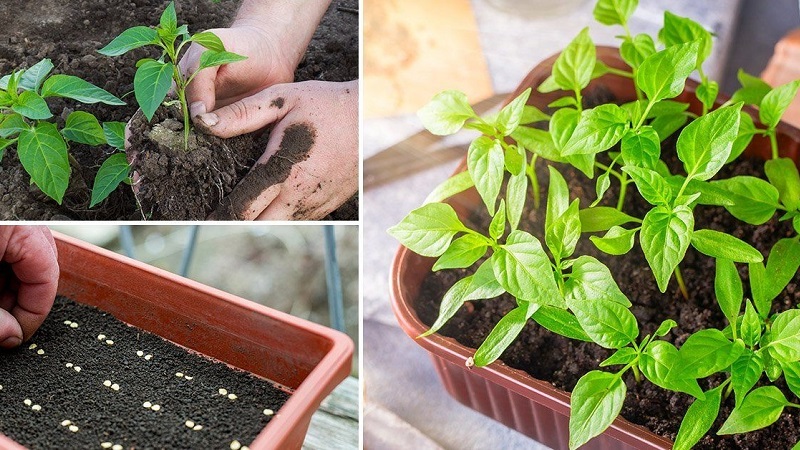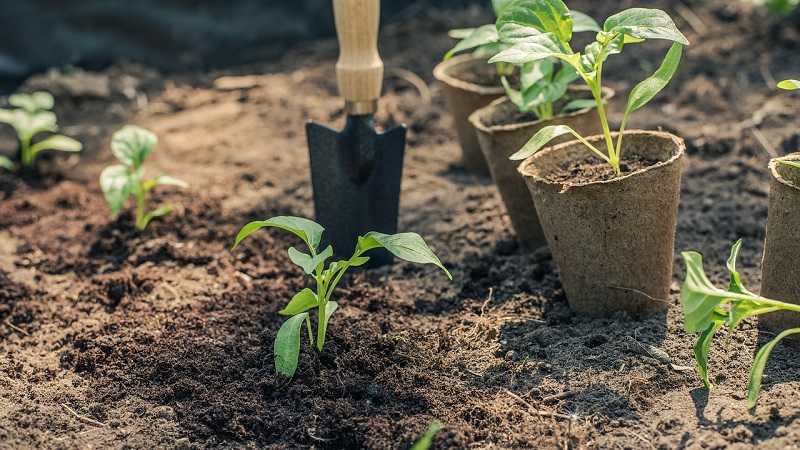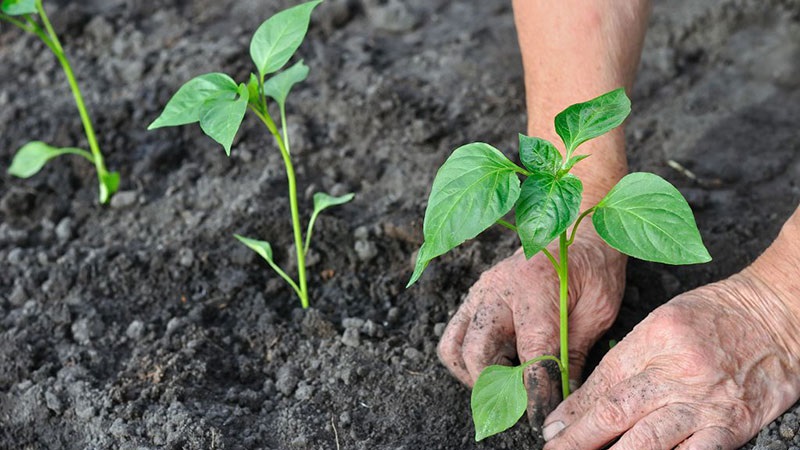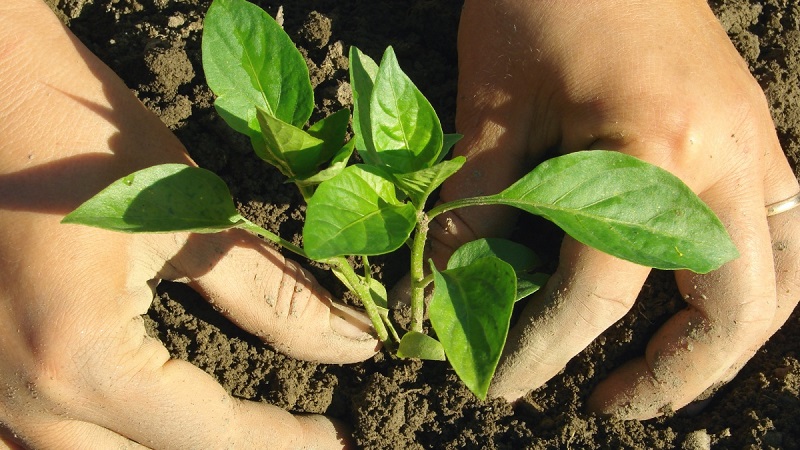Pepper planting rules: preparatory stage, timing and nuances of the process
With a gradual increase in temperature on the planet, temperate latitudes become more favorable for growing peppers. This vegetable contains a huge amount of vitamins and minerals, for which it is called a storehouse of health. However, growing peppers is a process that requires a lot of attention, patience and energy.
The content of the article
When and how to plant peppers for seedlings
Pepper fruits ripen 100-150 days after the first shoots appear... Seedlings are planted at the age of 60-80 days. Therefore, the best time to plant peppers for seedlings is between February 20 and March 10.
Only high-quality seeds are suitable for seedlings, so that they are sorted out and removed all puny and damaged. After that, the seed material is prepared for growing in our latitudes, because the homeland of pepper is hot Central America. The seeds, wrapped in cloth, are kept in hot water for 15 minutes, and then placed in the refrigerator for a day.

This the procedure can be replaced by treating seeds with chemicals, which will also protect them from fungal and viral infections, for example, with a fungicide solution. You can soak the seeds in a potassium permanganate solution for half an hour.
As a soil for sowing, it is recommended to use a ready-made store-bought substrate for peppers.... The container is selected at the rate of 100 ml per 1 seed. Before sowing, you need to rinse and wipe the container. Pour soil into three quarters, plant seeds and sprinkle them with soil 1.5 cm. Keep in a warm and humid place, wrap in bags or old warm clothes.
Planting seedlings in open ground
Before planting seedlings, choose a place and prepare the land... According to the correct crop rotation, pepper seedlings should be planted in areas where onions, carrots or cucumbers were grown, since after them the soil remains saturated with useful substances.
In the fall, after harvesting, the land is fed: scattered over the site with humus, superphosphate and potassium sulfate and evenly distributed with a rake, embedding fertilizer in the surface layer of the soil. A week before disembarkation, the soil is disinfected with "Fitosporin": 15 ml of the product per 10 liters of water.
Reference. For growing peppers, you cannot use the land on which potatoes, tomatoes or peppers were grown.

Timing
Seedlings should be planted in late April - early May depending on the cultivated variety. If these are varieties with an early ripening time, they should be planted 60 days after sowing. Cultivars with an average ripening time need 70 days after sowing, and cultivars of late time - 80 days. During this time, the plants have time to grow up to 20-25 cm.
Calendar dates vary depending on the region... In warmer regions, in the south of the country, where the soil has time to warm up faster, you can start planting seedlings from the second half of April.
Preparatory work
The holes in which the seedlings are transplanted must be the same size as the pot or utensilsin which the seeds germinated. Before planting, put 1 tbsp in each hole. l. mineral fertilizers rich in nitrogen, phosphorus and potassium (superphosphate, ash). Fertilizers are evenly distributed throughout the hole.
It can be useful:
Landing technology
The day before disembarkation, the seedlings are taken outside so that they begin to get used to the temperature and humidity.... Transplant the seedlings along with the soil in which they grew. When removing plants from the pot, the main thing is not to damage the soil ball if the root system has not had time to strengthen. Next, the seedlings are placed in the hole so that the entire root system is in its lower half. After that, the hole is poured with water, and when it is absorbed, it is covered with loose earth.
Important! Better to plant one plant per hole.

Seedling care
Peppers are picky plants that require constant care:
- regular watering;
- weeding;
- spraying against pests with drugs "Intavir", "Karate", "Confidor", "Agravertin", "Aktellik";
- fertilizing with fertilizers containing phosphates and potassium, 2 weeks after planting ("Kemira Lux", "Kristalon", "Gumi Kuznetsova").
For seedlings, constant access to sunlight is important.... If they were planted in places that are difficult to reach for light, use artificial lighting.
It is important to do it on time pinching planted seedlings... Remove side shoots in wet weather, and lower ones in dry weather. The main shoot, at the slightest roll of the tops, is tied up as the plant grows. Watering is carried out in the morning or in the evening to prevent burning of the foliage.
Planting peppers in a greenhouse
Due to the exactingness of the weather, pepper is often planted in greenhouses, where the conditions for its growth can be controlled. To prepare for the greenhouse, seedlings are grown in a soil mixture with a large amount peat, humus and soddy soils. Seedlings can be placed in the same greenhouse, which will allow the plants to quickly get used to the environmental conditions after transplanting.

The ripening time of seedlings is 40-60 days., which is less than in open space. Before planting, the soil is warmed up with warm manure or hot water, and then the temperature is maintained at + 21-28 ° C, which gives the maximum yield.
It is recommended to plant in the evening or in cloudy weather.... After planting, they regularly ventilate the greenhouse, and after 2-4 weeks they begin to feed them with fertilizers: infusion of mullein or bird droppings, infusion of ash.
Important! Fertilizing is done only after watering, otherwise the roots will burn out.
In a pot
Almost all varieties of peppers are suitable for growing in containers... A 5 liter pot is sufficient for planting. Plants of tall varieties, for example, berry pepper or vegetable pepper, are recommended to be planted in pots with a volume of 10 liters.
When buying, it is recommended to choose compact copies with many leaves, a thick stem and a developed root system. Prepare the soil before planting. The substrate for indoor peppers is mixed with ash, and then 1 tsp is added weekly for every 5 liters of earth. dolomite flour. Since the stalks of bell peppers do not support the weight of the fruit, tall plants are tied to a support.
Read also:
The nuances of planting pepper
When planting pepper, it is worth considering the distance between bushes and beds and the recommendations of the lunar calendar.

Auspicious days according to the lunar calendar
When to plant peppers based on the moon phase? Since the peppers grow on the surface, it is best to plant or sow peppers during the waxing moon according to the lunar calendar.
Auspicious days in 2020:
- March 1, 4-6, 25-28;
- 1-2, 24-25, 28-29 April;
- May 4-6, 25-26.
At what distance to plant
It is impossible to plant seedlings close to each other. The optimal distance for most varieties of peppers: 25-30 cm - between seedlings and 50-60 cm - between rows.
As for ornamental varieties of peppers grown in pots, it is recommended to plant one bush in one spacious pot (5 kg of soil is needed per plant) with a bar for future garters.
Is it possible to plant bitter and sweet peppers nearby
Since these plants propagate through cross-pollination, for which pollinating insects are needed, different varieties cannot be planted side by side.
If you plant bitter and sweet peppers nearby, as a result, you can get vegetables with mixed taste, unsuitable for further consumption. It is recommended to plant other vegetables between different varieties of peppers.
Conclusion
Growing pepper is a laborious process. Growing seedlings in a warm and comfortable environment, transplanting into pre-prepared soil rich in minerals, caring for the plant, occasionally tying, regular watering and pruning shoots is a painstaking work. But rich in nutrients and tasty peppers are worth the effort.